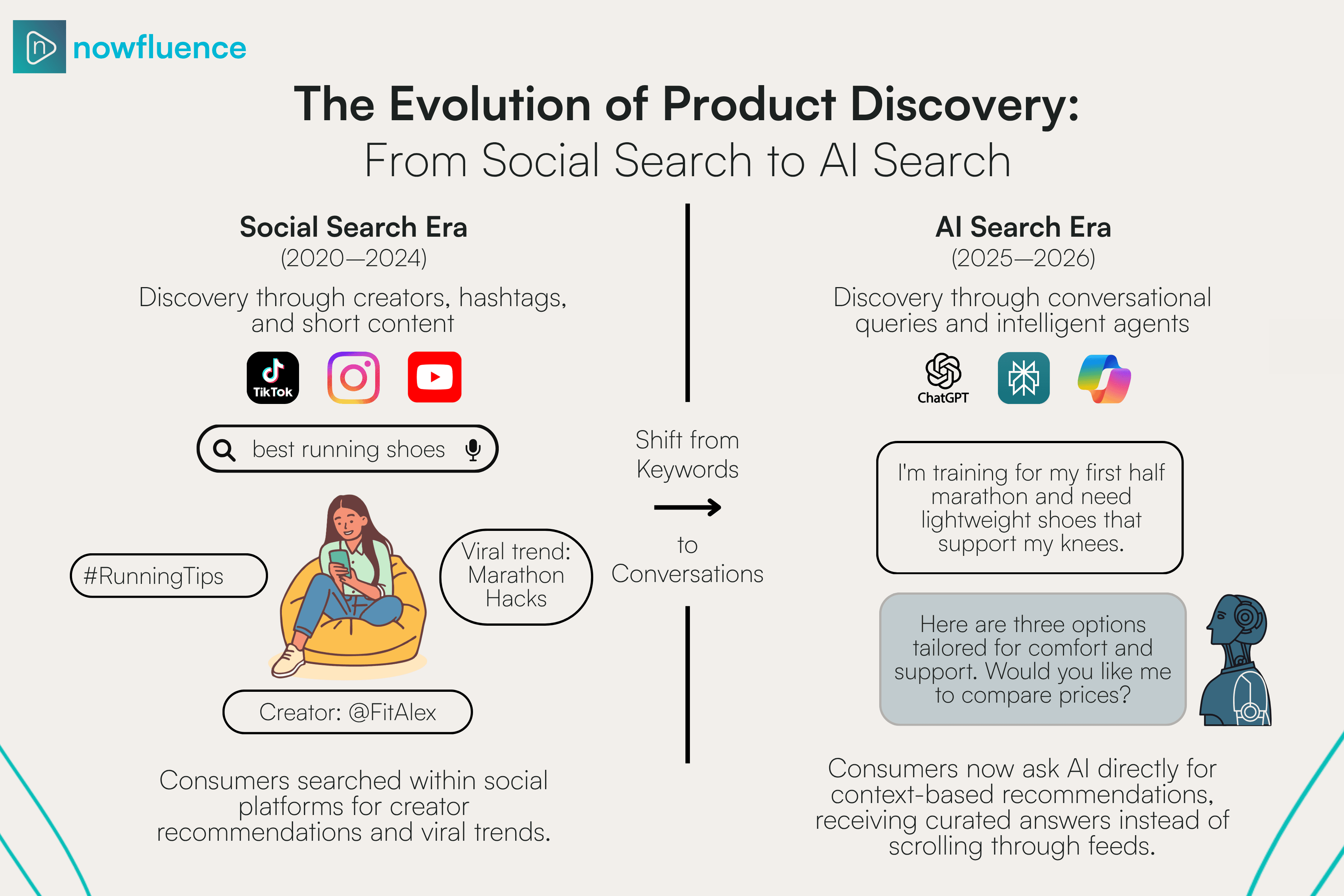From Social Search to AI Search: How Consumers Are Finding Products in 2026
Consumers are moving from social platforms like TikTok and Instagram to AI tools like ChatGPT and Perplexity to find products. Discover how brands can align influencer content with natural language search to stay visible in 2026.
October 14, 2025
The Next Big Shift in How People Discover Products
The way people find and choose products online is evolving faster than ever. Only a few years ago, social platforms like TikTok and Instagram had become the dominant search engines for Gen Z. Consumers didn’t just scroll for entertainment; they searched for skincare routines, tech recommendations, and travel tips through creators they trusted.
Now, in 2026, a new behavior is taking over. People are turning to artificial intelligence to make those same decisions.
Platforms such as ChatGPT, Perplexity, and Microsoft’s Copilot are acting as personal shopping assistants. They analyze context, preferences, and intent to deliver curated recommendations in seconds. The short keyword searches that once defined discovery are being replaced by full-sentence, conversational prompts.
Instead of typing “best running shoes,” a consumer might now ask, “I’m training for my first half marathon and need shoes that are light but still support my knees. What should I buy?”
AI Agents and the Rise of Agentic Commerce
According to Bain’s 2025 report on AI search behavior, shopping-related prompts in ChatGPT grew by 25 percent in the first half of the year, representing nearly ten percent of all searches. Click-through rates from AI-generated answers more than doubled.
Forbes describes this as the rise of agentic commerce, where AI agents do more than recommend. They research, compare, and even purchase products on behalf of users. Discovery no longer depends on appearing in someone’s social feed. It depends on being included in the shortlist that an AI agent presents to a buyer.

How Brands Can Stay Visible in AI Search
This transformation raises a crucial question for every brand. If AI is now the front door to commerce, how do you make sure your products are visible when consumers no longer search, but ask?
The answer lies in content strategy, and influencer marketing sits at the center of that shift. The same Forbes article emphasizes that AI search engines depend on rich, context-driven content to understand intent. Influencers, through authentic storytelling, naturally create this kind of language.
When a creator says, “I’ve been looking for a lightweight jacket for early-morning runs, and this one keeps me warm without feeling bulky,” that content directly matches the type of long, natural query consumers use in ChatGPT or Perplexity. If that post is accessible to AI crawlers, it helps define how those models connect a brand’s product to real-world needs.
Influencers Are Now Training the Algorithms
Influencers no longer just inspire people; they also shape how algorithms understand products. The words they choose, the way they describe experiences, and even the structure of their posts can influence which products are surfaced by AI platforms.
This marks a new alignment between influencer marketing and search optimization. Brands that once optimized for engagement now need to optimize for AI discoverability.
That means ensuring creator content includes clear product context, natural phrasing, and metadata that AI agents can interpret. It also means distributing influencer content across formats and platforms that are easily crawled by generative models such as ChatGPT, Perplexity, and Copilot.
Why This Matters for the Future of Influencer Marketing
This shift extends far beyond SEO. As AI systems become responsible for a growing share of online discovery, influencer content becomes a core part of the dataset that informs what products people see. It is not only about reaching human audiences, it is about training the AI engines that now shape consumer behavior.
In the coming years, aligning influencer storytelling with natural, intent-based language will be critical. The brands that adapt early will not just appear in social feeds but will also be featured in AI-generated recommendations, summaries, and shopping lists.
Those who understand this change will define the future of digital visibility. Being recognized by the right AI agent at the right moment could soon matter more than being seen by millions of people.
Because in 2026, visibility belongs to the brands that speak both to humans and to machines.
Want to discuss insights from this study? Reach out to our research team.